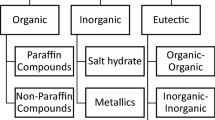Abstract
Thermoforming is one of the most versatile and economical processes available for polymer products, but cycle time and production cost must be continuously reduced in order to improve the competitive power of products. In this study, water spray cooling was simulated to apply to a cooling system instead of compressed air cooling in order to shorten the cycle time and reduce the cost of compressed air used in the cooling process. At first, cooling time using compressed air was predicted in order to check the state of mass production. In the following step, the ratio of removed energy by air cooling or water spray cooling among the total removed energy was found by using 1-D analysis code of the cooling system under the condition of checking the possibility of conversion from 2-D to 1-D problem. The analysis results using water spray cooling show that cycle time can be reduced because of high cooling efficiency of water spray, and cost of production caused by using compressed air can be reduced by decreasing the amount of the used compressed air. The 1-D analysis code can be widely used in the design of a thermoforming cooling system, and parameters of the thermoforming process can be modified based on the recommended data suitable for a cooling system of thermoforming.
Similar content being viewed by others
References
M. K. Warby, J. R. Whiteman, W. G. Jiang, P. Warwick and T. Wright, Finite element simulation of thermoforming processes for polymer sheets, Mathematics and Computers in Simulation 61(3–6) (2003) 209–218.
J. L. Throne, Technology of Thermoforming, Hanser Publishers, Munich, New York, USA, (1987).
G. Aguilar, B. Majaron, K. Pope, L. O. Svaasand, E. J. Lavernia and J. S. Nelson, Influence of nozzle-toskin distance in cryogen spray cooling for dermatologic laser surgery, Lasers in Surgery and Medicine 28(2) (2001) 113–120.
Q. Cui, S. Chandra and S. McCahan, The effect of dissolving salts in water sprays used for quenching a hot surface. Part 2: spray cooling, Journal of Heat Transfer 125(2) (2003) 333–338.
Y. Mitsutake, M. Monde, Y. Kojima and A. Mikami, Characteristics of transient heat transfer on a hot surface during cooling with spray, Thermal Science and Engineering 12(4) (2004) 41–42.
J. A. Clements and S. A. Sherif, Thermal analysis of roof spray cooling, International Journal of Energy Research 22(15) (1998) 1337–1350.
S. S. Hsieh, T. C. Fan and H. H. Tsai, Spray cooling characteristics of water and R-134a. Part I: nucleate boiling, International Journal of Heat and Mass Transfer 47(26) (2004) 5703–5712.
J. Yang, L. C. Chow and M. R. Pais, Nucleate boiling heat transfer in spray cooling, Journal of Heat Transfer 118(3) (1996) 668–671.
F. P. Incropera and D. P. Dewitt, Fundamental of Heat and Mass Transfer, John Wiley & Sons, New York, USA, (1996).
A. Bejan, Convection Heat Transfer, John Wiley & Sons, New York, USA, (1995).
Z. Z. Li, K. S. Heo and S. Y. Seol, Timedependent optimal heater control in thermoforming preheating using dual optimization steps, International Journal of Precision Engineering and Manufacturing 9(4) (2008) 51–56.
R. J. Goldstein, E. M. Sparrow and D. C. Jones, Natural convection mass transfer adjacent to horizontal plates, Int. J. Heat and Mass Transfer 16 (1973) 1025–1037.
J. R. Lloyd and W. R. Moran, Natural convection adjacent to horizontal surfaces of various plan forms, Journal of Heat Transfer 96 (1974) 443–451.
B. M. Pikkula, J. W. Tunnell, D. W. Chang and B. Anvari, Effects of droplet velocity, diameter, and film height on heat removal during cryogen spray cooling, Annals of Biomedical Engineering 32(8) (2004) 1131–1140.
Author information
Authors and Affiliations
Corresponding author
Additional information
This paper was recommended for publication in revised form by Associate Editor Dongsik Kim
Zhen-Zhe Li received his B.S. degree in Mechanical Engineering from Yanbian University, China, in 2002. He then received his M.S. degree in Aerospace Engineering from Konkuk University, South Korea, in 2005. He then received his Ph.D. degree in Mechanical Engineering from Chonnam National University, South Korea, in 2009. Dr. Li is currently a Researcher of the Department of Mechanical Engineering, Chonnam National University, South Korea. Dr. Li’s research interests include applied heat transfer, fluid mechanics and optimal design of thermal and fluid systems.
Kwang-Su Heo received his B.S. degree in Mechanical Engineering from Chonnam National University, South Korea, in 1998. He then received his M.S. and Ph.D. degrees in Mechanical Engineering from Chonnam National University, South Korea, in 2003 and 2008, respectively. Dr. Heo is currently a Post-doctorial Researcher of the Department of Mechanical Engineering, KAIST(Korean Advanced Institute of Science and Technology), South Korea. Dr. Heo’s research interests include applied heat transfer, fluid mechanics and thermal analysis of superconductor.
Dong-Ji Xuan received his B.S. degree in Mechanical Engineering from Harbin Engineering University, China, in 2000. He then received his M.S. degree in Mechanical Engineering from Chonnam National University, South Korea, in 2006. He is currently a Ph.D. candidate of the Department of Mechanical Engineering, Chonnam National University, South Korea. His research interests include control & optimization of PEM fuel cell system, dynamics & control, mechatronics.
Seoung-Yun Seol received his B.S. degree in Mechanical Design from Seoul National University, South Korea, in 1983. He then received his M.S. degree in Mechanical Engineering from KAIST(Korean Advanced Institute of Science and Technology), South Korea, in 1985. He then received his Ph.D. degree in Mechanical Engineering from Texas Tech University, USA, in 1993. Dr. Seol is currently a Professor of the School of Mechanical and Systems Engineering, Chonnam National University, South Korea. Dr. Seol’s research interests include applied heat transfer, fluid mechanics and thermal analysis of superconductor.
Rights and permissions
About this article
Cite this article
Li, ZZ., Heo, KS., Xuan, DJ. et al. A study on cooling efficiency using 1-d analysis code suitable for cooling system of thermoforming. J Mech Sci Technol 23, 607–613 (2009). https://doi.org/10.1007/s12206-008-1123-0
Received:
Revised:
Accepted:
Published:
Issue Date:
DOI: https://doi.org/10.1007/s12206-008-1123-0




